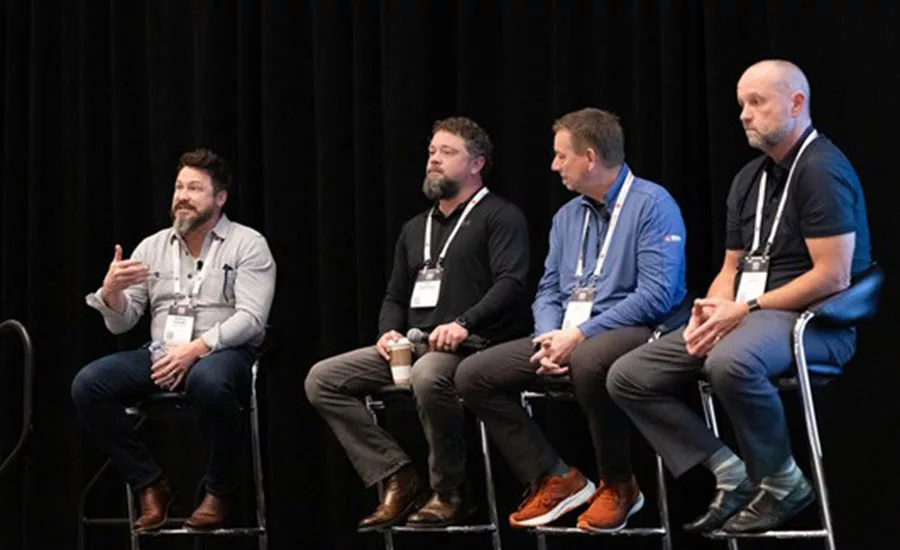OSHA on the Roof, Part I
Under the Occupational Safety and Health Act of 1970, OSHA is authorized and mandated to conduct scheduled and random workplace inspections to determine employer compliance to the industrial and construction standards. While most inspections are conducted without forewarning (up to a $1000 fine and/or 6 months in jail for alerting an employer), OSHA may inform the employer of an upcoming inspection under specific conditions.
The Focused Inspection
Compliance officers (COs) may choose to approach the workplace inspection by focusing on the four major ways in which industrial and construction workers seriously injure themselves or die. These include falls from heights, struck by an object, caught in or between objects, and electrocution. This analysis can be made relatively quickly and simply. The CO may site the employer for flagrant or willful violations, but reserves the right to make specific recommendations for reducing or eliminating the potential hazard.The focused inspection streamlines the inspection procedures. It allows the CO to help the employer who is working toward compliance and locate the employer who regards his employees as consumables. The resulting “comprehensive” inspection of such an employer may prove costly before the desired results are reached.
Employer’s Right to Refuse
If, for any reason, the employer refuses consent for the CO to enter his or her property, then the officer must seek a judicially authorized search warrant. Where as this once took up to five days to acquire, it now takes only hours and the resulting inspection may prove very uncomfortable for the employer. There are three conditions in which a CO may inspect without a warrant: 1) when you consent; 2) when violations are in plain view from public property; 3) during an emergency or situations immediately dangerous to life and health (IDLH). Any senior management official can consent. Statistically, employers who deny OSHA immediate entry are cited with twice as many violations per inspection and are charged almost double the penalties as those who do not. Being hospitable, or even quietly reserved, will result in a cordial and professional meeting.Inspection Priorities
There are five basic situations that may lead to an OSHA inspection.1. Imminent Danger: First priority is given whenever a CO is reasonably suspicious that an employee may be exposed to a hazard which may cause death or serious physical harm immediately or before remediation is possible.
2. Catastrophes and Fatalities: A single employee fatality or hospitalization of five or more is a second priority. These must be reported to OSHA within 48 hours for investigation, whether or not a violation of a regulation has occurred.
3. Employee Complaints: The most common cause of an inspection, an employee may report (anonymously or identified) alleged violations or unsafe working conditions 24/7/365 by simply calling 800.321.OSHA.
4. Programmed Inspections: These are aimed at specific, high-hazard industries, occupations or health-related substances. For construction, there are computer databases that target random building permits as well. Special emphasis programs may also be developed when a particular accident (falls from ironwork, scaffold collapse, trench cave-ins) is frequently reported.
5. Follow-Up Inspections: There is obviously a need to reinspect in order to validate that corrective safety measures have been taken by the employer. “Failure to Abate” violations can carry stiff penalties and constitute a considerable portion of OSHA’s revenue.
The Inspection Process
There are four components to an OSHA inspection. They are clearly defined and mandatory. You are guaranteed the same due process as any other employer, and the procedures must be standard and sequential in order to be legal.
Step 1: Opening Conference
- Employers should always ask the CO for his or her credentials. Ask for a business card for your records and future communications. A call to the local area office can verify identification.
- The CO does not have to ask for consent or inform you of your rights to request a search warrant.
- The method used to select your firm for inspection is discussed, as well as whether a focused or comprehensive inspection format will be followed.
- There will be a review of records, including OSHA 200 log, OSHA poster, accident reports, training records, medical monitoring, site safety inspections (JSA), etc.
- You will be told how to obtain a copy of the OSHA standard and employee complaint (anonymous).
- There will be a selection of an employer’s representative to accompany inspector. Option 1: Selection of an employee’s representative by employees or CO to accompany inspector and report back to the employees on the inspection results (never selected by employer). Option 2: CO may consult with a significant number of employees where an employee’s rep is not available, ensuring they understand the inspection process.
Step 2: Site Inspection
- The CO determines the site route and duration of the inspection. It may cover part or all of the employer’s or third party’s property.
- The CO directly observes site conditions and work practices, inspecting engineering, administrative and PPE hazard controls. There will be condition measurements, such as photos, videos and monitoring instrumentation (air, noise, heat, cold). The employer may also duplicate photos with his own camera to help assess conditions requiring abatement.
- The CO may interview or consult employees. Employees are protected from discrimination by the employer for exercising his/her OSHA rights. Even a striking employee has the right to accompany the inspector.
- The employer should not “hover.” The employer and employee’s reps may wish to take notes or record comments to discuss later.
- The employer should assess the issue of the inspection and focus on just that. Do not volunteer any information.
- Typically, the CO will notify the employer of unsafe acts or conditions and offer corrective recommendations if asked. IDLH conditions or acts should be corrected immediately or the employees removed from the hazard until it is abated. If the hazard is mitigated quickly with “good faith” effort, the CO will report such actions, possibly affecting a citation or penalty. (The employer may choose to assign a worker to immediately repair/replace equipment, barricade dangerous area, etc.)
Step 3: Closing Conference
- After site inspection, the CO will conduct a private conference with the employer and employee’s rep to discuss his findings during inspection. (Tape recording and note taking can clarify details and facilitate future discussion. Ask the CO for his permission.)
- Be patient and do not interrupt the CO. You will have a chance to comment and ask questions at the end. Feel free to disagree with the CO, but remain polite.
- A frank discussion of findings and proposed corrective measures takes place.
- The CO may give the employer a copy of “Employer’s Rights and Responsibilities Following an Inspection” (booklet #3000) and review contents.
- The employer is encouraged to ask any procedural questions at this time.
- The employer may produce any documentation or information showing his/her past/continuing efforts regarding worker health and safety (prepared in advance along with revised Safety and Health Program). The employer may advise the CO of any identified hazards that were abated during the inspection that he or she may not be aware of.
- More than one closing conference may be required and scheduled if monitoring, photo development or lab test results are pending or further hazard analysis is required over longer periods.
- The CO discusses all the support features available at local OSHA Area Offices, including pertinent literature; standards and regulations; in-house technical experts; training classes; voluntary compliance programs; and other agencies and professional safety organizations.
- If employee rep is not present during either opening or closing conferences, then a separate meeting is held with him or her to discuss safety topics and findings of direct employee interest.
- Penalties and fines are not discussed or assessed during this inspection phase. Your CO is not the individual who makes these determinations.
Preparing for the Inspection
In reality, there is no dependable system to determine when or if you will be inspected by OSHA. Drafting response plans with your safety director, management representative, project managers and foremen is always prudent. Having a reasonable understanding of the inspection process may provide the employer with a plan to organize documentation and records, educate field personnel in what’s expected of them and regularly assess the work sites (with a Job Safety Analysis) to identify hazards before they accumulate. During the closing conference these three tasks will also demonstrate your proactive attitude to employee safety as well as your “good faith” willingness to continually improve workplace safety.
In a future issue, I will discuss the violation and penalty phases of the OSHA inspection process.
SIDEBAR
The following questionnaire may assist you in preparing for an OSHA inspection:1. Do you have a current set of 1910 (General Industry) and 1926 (Construction) OSHA Standards?
2. Is your Safety and Health Program up-to-date and pertinent to the work you’re presently performing?
3. Are your accident/near-miss reports, OSHA 200 log and other safety documents current, organized and available?
4. Have you documented your efforts to prevent accidents and injuries from recurring?
5. Have you trained your office and field management personnel in the procedures to follow if an inspection occurs?
6. Have you conducted a safety analysis of all of your subcontractors?
7. Have you designated a competent person with the training, experience and authority to correct hazards on every work site?
8. Have you assessed your host employer’s contractor safety and health programs for coordination with your own?
9. Do you have a “tag-out” policy for damaged or dangerous tools and equipment on job sites? (Defective tool or equipment that is tagged out and not in use cannot be cited in violation.)
10. Is there a predetermined call-tree in place to contact you and your safety director to attend a site inspection?
11. Are you prepared with standards, camera/video, tape recorder and notebook to document inspection on short notice?
12. Have you asked your employees to designate an employee representative to attend OSHA’s conferences and inspection?
13. Have you implemented a regular site-safety analysis program to detect any potential OSHA violations?
14. Have you conducted and evaluated a practice OSHA Inspection drill on any of your job sites?
Looking for a reprint of this article?
From high-res PDFs to custom plaques, order your copy today!



